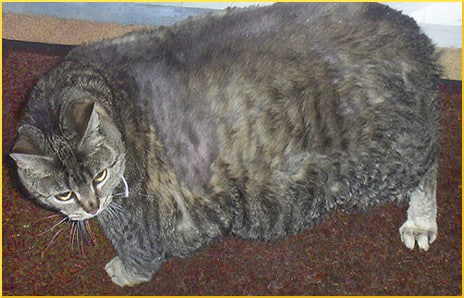According to the latest figures, 52 percent of pet dogs in America are overweight or obese: about 43 million dogs. The cat statistics are even worse—an estimated 57 percent of cats, or 55 million animals, are overweight or obese. There has been an alarming increase in pet obesity during recent years, and nobody seems to know quite what to do about it. The fact that more than half of the pets in the United States are unhealthily large is what keeps enrollment up in veterinary colleges. The need is great, because excess weight causes many problems:
Osteoarthritis, Insulin Resistance and Type 2 Diabetes, High Blood Pressure, Heart and Respiratory Disease. Cranial Cruciate Ligament Injury. Kidney Disease. Many Forms of Cancer, Decreased life expectancy
Cats are particularly at risk because they tend to develop Type 2 diabetes, which requires their owners to administer insulin shots. Anyone who has ever tried to give a cat a pill, or even an unwelcome brushing, knows how easy it is to be scratched or bitten by an irate feline. The needed shots are not at all easy.
DVM360.com, a website for vets, lists several possible causes for obesity in dogs. They include breed predisposition, neutering, medications, adipokines, nutrition, environment, and age. Not just dog age, but owner age, implying some owners are too aged and infirm to give their dogs the necessary amount of vigorous activity. These days, because they see so much of it, people have trouble identifying obesity in themselves, their children, or their pets.
Here is the lowdown on obesity recognition by dog owners, as discovered by researchers who used a measurement scale known as Body Condition Score or BCS:
Obese dogs were twice as likely to have obese owners as nonobese dogs were… Interestingly, while obese owners are more likely to have obese dogs, they do not appear to differ in their misperception of their dogs’ BCS when compared to nonobese owners.
To treat dog obesity, there are basically three choices: diet, lifestyle (exercise), and pharmaceuticals. Diet change takes work, because any plan has to be tailored to the individual canine, and care must be taken not to allow protein starvation with its resulting loss of lean muscle tissue. The site recommends low-calorie treats, games and grooming as rewards, rather than high-calorie treats; and forbids giving dogs table scraps.
Begging for food is more of a behavioral problem than it is a hunger problem, and if this relationship is not considered in weight-loss programs, the program is doomed to fail.
Recently, Dr. Pretlow met a veterinarian from the Netherlands who is very concerned about the overwhelming number of obese pets he sees in his practice. Aside from the predictable cats and dogs, his patients include horses, birds, goats, ferrets, guinea pigs, and more. Apparently, the veterinary literature does not shed much light on obesity among pets, aside from the standard advice to cut calories and increase exercise. This is what Dr. Pretlow told him:
The approach for treatment of obese pets is exactly the same as that for obese kids. It’s the “pet parent” that is the problem. Pet parents give treats/foods to their pets to gain affection from the pets, resulting in the pets getting hooked (addicted) to the foods. The pet parents likewise become co-dependent on the treats as a result of the affection garnered.
At some point, the pet parent realizes that the pet is getting huge and attempts to curb the foods. Both the pet parent and the pet then experience withdrawal symptoms, plus the pet becomes annoyed and aggressive and may even bite the pet parent if foods are restricted. Both the pet parent and pet must go through withdrawal from the foods, e.g. “tough love.”
On a lighter note, Dr. Pretlow suggested that the behavioral addiction methods offered by the W8Loss2Go smartphone app would be useful, if only the dog or cat could swipe the app screen with tongue or paw. As in so many areas of obesity awareness, a contradiction exists.
David Berreby reported for Aeon Magazine on the inexplicable weight gain that seems to have overcome all animals, not just pets. He acknowledges that humans lack restraint when giving their pets treats, and that dumpsters contain rich leavings for feral animals to feast upon. But what about laboratory animals? Over the past few decades, the creatures used by scientists for experiments have also gotten heavier, despite the fact that their diets and opportunities for exercise have remained constant. Berreby writes:
Obviously, if animals are getting heavier along with us, it can’t just be that they’re eating more Snickers bars and driving to work most days. On the contrary, the trend suggests some widely shared cause, beyond the control of individuals, which is contributing to obesity across many species.
Your responses and feedback are welcome!
Source: “2014 Obesity Facts & Risks,” PetObesityPrevention.org, 2014
Source: “Obesity in dogs, Part 1: Exploring the causes and consequences of canine obesity,” Dvm360.com, 04/01/11
Source: “David Berreby rejects the diet+exercise model of obesity epidemic causation,” AeonMagazine.com, 06/19/13
Image by psyberartist


 FAQs and Media Requests:
FAQs and Media Requests: 











